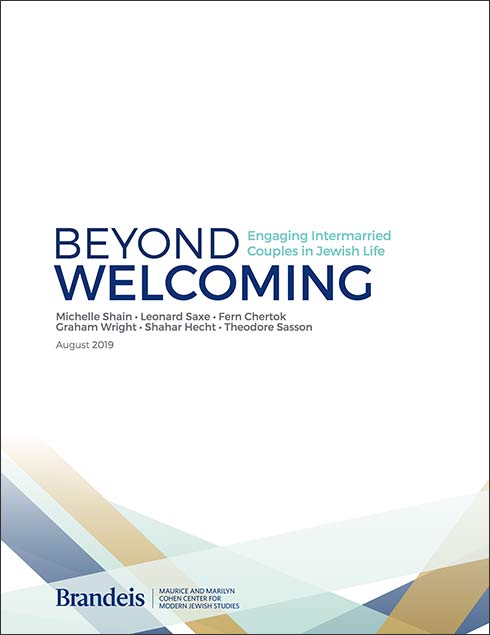Beyond Welcoming: Engaging Intermarried Couples in Jewish Life
Michelle Shain, Leonard Saxe, Fern Chertok, Graham Wright, Shahar Hecht, Theodore Sasson
August 2019
 “Beyond Welcoming” is the first large-scale study of the marriages and committed relationships of Gen X and millennial Jews, and the first to systematically collect data from non-Jewish partners about their backgrounds, experiences, and perspectives. The study was designed with the goal of understanding which programs and policy initiatives would best serve the Jewish community in an era where intermarriage is pervasive and young adults in the United States are distancing themselves from religion and religious institutions.
“Beyond Welcoming” is the first large-scale study of the marriages and committed relationships of Gen X and millennial Jews, and the first to systematically collect data from non-Jewish partners about their backgrounds, experiences, and perspectives. The study was designed with the goal of understanding which programs and policy initiatives would best serve the Jewish community in an era where intermarriage is pervasive and young adults in the United States are distancing themselves from religion and religious institutions.
The findings of this study draw on survey data collected from both members of 607 Jewish+Jewish couples and 521 Jewish+non-Jewish couples. Couples were either married, engaged, or cohabiting. Data was collected in spring/summer 2017.
Key Findings
Religious Background
-
Jews who are in a relationship with a non-Jew generally had fewer Jewish childhood experiences and fewer post-high school Jewish experiences than Jews who were in relationships with other Jews.
-
Non-Jews who were in relationships with Jews generally did not have substantial religious experiences during their childhood or post-high school years.
Relationships
-
For most Jewish+non-Jewish couples, differences in religious background were not a fraught issue early in their relationship.
-
Most respondents in both Jewish+Jewish and Jewish+non-Jewish couples were highly satisfied with their relationships with their partners and their relationships with their own and their partners’ parents.
Jewish and Religious Identification and Engagement
-
Jews in Jewish+Jewish couples were more likely to identify as Jews, to value being Jewish and to engage in Jewish behaviors than Jews in Jewish+non-Jewish couples.
-
The majority of non-Jews in Jewish+non-Jewish couples considered themselves atheist, agnostic, or of no religion and, aside from Christmas, Christian religious traditions were rarely observed.
-
The majority of young couples, both Jewish+Jewish and Jewish+non-Jewish, felt welcome in the Jewish community.
-
Children of Jewish+Jewish couples were more likely than children of Jewish+non-Jewish couples to have a Jewish naming ceremony or brit milah (Jewish circumcision and naming ceremony); to attend organized Jewish programs or activities; to attend Jewish daycare, nursery school or preschool; and to be identified by their parents as Jewish.
-
When the Jewish partner in Jewish+non-Jewish couples was female, the couple was more likely to agree that they are raising their child exclusively Jewish by religion, and more likely to have their oldest child attend an organized Jewish program or activity for young children.